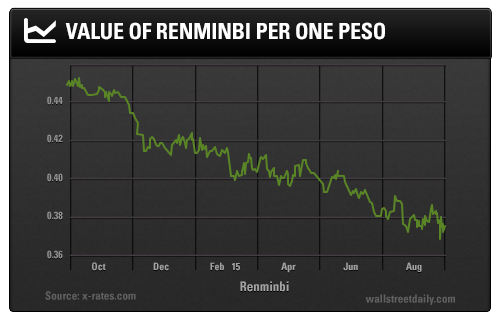It’s time to turn our backs on China and embrace Mexico by replacing any exposure to the former in your emerging-market (EM) portfolio with positions tied to the latter.
The EM sector has been a challenging investment proposition from a risk/reward perspective lately. In fact, this summer was downright scary!
In August, the (NYSE:EEM) benchmark collapsed by 9%, fueling fears that investors were in the midst of a mass EM liquidation. The result was a ripple effect throughout global financial markets and a rapid rise in volatility.
The rising volatility was also fueled, to a large extent, by the strength in the U.S. dollar over the past 15 months. This contributed to the confusion in EM markets.
The Fed’s decision to hold rates was determined largely by the weakness in data coming out of China and other emerging markets.
Investors are increasingly concerned about the growing vulnerabilities in emerging market economies, particularly China, as they reassess the global growth outlook. China’s equity markets plunged in June and early July, fracturing investor confidence and weighing on asset prices worldwide.
Emerging markets typically invite volatility to your portfolio, more so than usual now.
So what else looks good in the EM world and offers return opportunities with less volatility? Mexico.
More Competitive Mexico
Let’s compare currencies to start. The Chinese renminbi has appreciated approximately 50% against the Mexican peso over the last decade. Just look at how the value of one Chinese renminbi per one Mexican peso has dropped over this past year.

This means that, on a dollar-equivalent basis, if you want to import into the United States, Mexico is far more competitive than China.
The State of Foreign Trade
From a foreign trade standpoint, Mexico’s association in NAFTA (North American Free Trade Agreement) is a big advantage compared to China. This means goods exchanged between the United States and Mexico aren’t subject to the myriad barriers and tariffs imposed on goods flowing to and from China.
China did cut its tariffs on 14 categories of imported consumer goods in June in an attempt to spur domestic consumption and rebalance the economy from its traditional reliance on debt-funded investment. But analysts have cautioned that the effects of these cuts would be modest at best.
For instance, China cut its average import duties on men’s and women’s suits and outerwear from 24% to 17.5%, on shoes from 23% to 12%, and on fur clothing from 23% to 10%. But the products benefiting from the reductions account for less than 10% of China’s total imports.
Just look at the influx of cross-border shoppers into Hong Kong – it’s a Chinese territory with far lower taxes due to its status as a free port.
Furthermore, the pace of trade liberalization between the United States and China is slowing.
In 2010 through 2014, 109 new trade deals came into force, down from 128 during the five years ended in 2009, according to the World Trade Organization (WTO). The biggest deal was the 12-country Trans-Pacific Partnership (TPP).
The TPP, the cornerstone of the Obama Administration’s economic policy in the Asia Pacific, seeks to provide new and meaningful market access for American goods and services exports. But it also sets high-standard rules for trade, and now seems to have run ashore. Negotiating new pacts is becoming more challenging as average tariffs have fallen.
Furthermore, deals between the United States and China, among other Asian nations in the TPP, focus on much thornier issues, such as intellectual property and labor standards. As a result, Asian nations have recently shifted focus to more regionalized trade agreements, frustrated by the slowdown in TPP’s developments.
And speaking of labor, even while one must take both nations’ statistics with some skepticism, they offer some interesting comparisons.
As of July, Mexico’s unemployment stands at 4.72%, and is well off its all-time (not very) high of 5.93% as reported by the Instituto Nacional de Estadistica y Geografia. (This statistic, like that of the unemp, represents the number of people actively looking for a job as a percentage of the labor force.)
Meanwhile, the Chinese government statistics report an official unemployment rate of 4.04%, however, many economists believe the number is closer to 10%.
Slow and Steady Growth
Finally, let’s look at GDP trends.
China’s growth rate, while higher than Mexico’s, has been falling steadily for almost a decade from double digits to 7%. Mexico’s GDP growth, on the other hand, is at a lower 3% but has been stable for years.
As such, proximity alone isn’t the only reason the United States is Mexico’s numero uno trading partner in both imports and exports. In fact, 70% of Mexico’s exports go to the United States, while 47% of its imports come from the United States, according to the Observatory of Economic Complexity.
Finally, Mexico’s life expectancy of males at birth is only one notch higher than China’s (75 years versus 74 years), according to the World Bank.
But an interesting study recently released from Berkeley Earth indicated that China’s air pollution kills 4,000 people a day.
There’s a lot more that could be examined when it comes to this issue of investing in China versus Mexico. But, in the end, simple macroeconomics dictates that Mexico looks to be your better bet.
by Shelley Goldberg
